Ryogoku Kokugikan 両国国技館
|
Title   • File Name • File Name   • Date • Date   • Position • Position   |
|

The Kokugikan as seen from JR Ryogoku Station platform.
|
|

Way to Kokugikan. The guarded side gate on the right is for sumo wrestlers.
|
|

Taiko drum tower
|
|

Taiko drum tower
|
|

Sumo wrestler banners
|
|

Sumo wrestler and sumo stable banners
|
|

Kokugikan
|
|

Kokugikan ticket office (right). Ticket prices range from 2,100 yen to 14,300 yen.
|
|

Kokugikan ticket office. Cheap tickets costing 2,100 yen are sold every day of the tournament, but sell out fast by noon or so.
|
|

Gate to enter Kokugikan.
|
|

At the gate, you might see a famous former wrestler (like former Takamiyama from Hawaii, now Stablemaster Azumazeki) taking your ticket.
|
|

Front of Kokugikan. The wide stairs make it quick for many people to exit the building. It is a sleek, modern building with a spacious interior. The roof collects rainwater for use in the toilets.
|
|
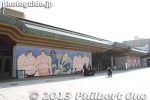
After you go through the ticket gate, the front of Kokugikan has two large murals.
|
|
|
|
|
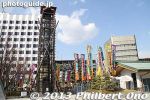
Taiko drum tower
|
|
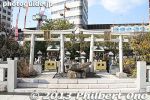
Two small shrines outside.
|
|

Sumo wrestlers enter through a side entrance. Fans wait for their favorite wrestlers.
|
|

Entrance lobby. At the end of the lobby is a trophy showcase. On the last day of the tournament, the tournament winner will walk through here to his car for a victory parade amid a large crowd.
|
|

Side of lobby. (Passing out free calendar posters during Jan. tourney.)
|
|

Sumo mural in lobby.
|
|
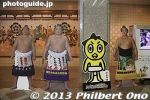
In the entrance hall are life-size cutouts of the top wrestlers.
|
|
|

Trophy case in lobby. This is the Emperor's Cup awarded to the tournament winner.
|
|

Emperor's Cup. This is what all sumo wrestlers dream about.
|
|
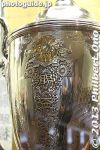
Closeup of Emperor's Cup.
|
|

Nameplates of tournament winners on Emperor's Cup
|
|
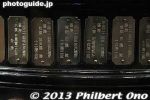
Closeup of nameplates of tournament winners on Emperor's Cup.
|
|

Old Nameplates of tournament winners that were on the Emperor's Cup.
|
|

Old Nameplates of tournament winners that were on the Emperor's Cup.
|
|
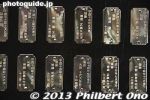
Closeup of old Nameplates of tournament winners that were on the Emperor's Cup.
|
|
|
|

Plaques for the Three Outstanding Prizes (Technique, Outstanding Performance, and Fighting Spirit) awarded by two newspapers.Technique Prize (Gino-sho), Outstanding Performance (for most Yokozuna/Ozeki upsets, Shukun-sho), and Fighting Spirit (Kanto-sho).
|
|
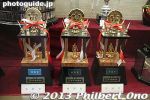
Trophies for the Three Outstanding Prizes (Technique, Outstanding Performance, and Fighting Spirit) from the Japan Sumo Association.Technique Prize (Gino-sho), Outstanding Performance (for most Yokozuna/Ozeki upsets, Shukun-sho), and Fighting Spirit (Kanto-sho).
|
|

The tournament winner receives numerous prizes from various organizations and companies.
|
|

Prize from Miyazaki Prefecture.
|
|
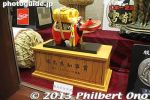
Prize from Fukushima Prefecture.
|
|
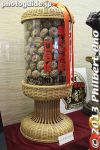
Mushrooms from Oita Prefecture.
|
|
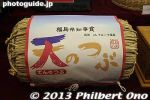
Another prize from Fukushima Prefecture.
|
|
|
|

Prime Minister's Cup on left, the middle is the President Chirac Award from France, and the glass on the right is a prize from the Czech Republic.President Chirac is a sumo fan. There is also a Czech wrestler in the lower division.
|
|

Prize from the United Arab Emirates.
|
|

In the back on the left is a prize from Mexico and one from Hungary on the right. In the front on the left is a prize from Mongolia, middle is from NHK, and right is from China.
|
|

Sumo Museum. Open only during tournament days. Free admission.The wall on the left show portraits of all the yokozuna in the modern era.
|
|
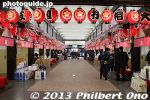
Sumo service entrance for groups.
|
|

Corridor and souvenir shops.A corridor encircles the arena.
|
|

Sumo figurines.
|
|
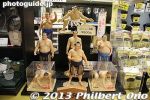
Sumo figurines.
|
|
|
|
|
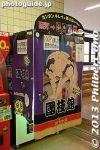
Print Club photo sticker booth.
|
|

Kokugikan Cafe snack bar
|
|

Bios and pictures of all sumo wrestlers in top Makunouchi division.
|
|

The bios and pictures are categorized according to prefecture. All wrestlers who were/are active in the modern era are introduced. Two wrestlers from Shiga Prefecture: Kurama and Misugisato.
|
|

Non-Japanese sumo wrestlers who made it to Makunouchi Division. Four from USA (Hawaii), four from Mongolia, and one from Bulgaria (Kotooshu) as of 2006.
|
|

Bulgaria (Kotooshu)
|
|
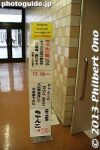
Entrance to the dining room for chanko-nabe. It's downstairs in the basement.
|
|

The chanko-nabe menu changes a few times during the tournament. The recipes are from various sumo stables.
|
|
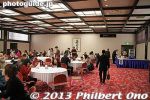
The banquet hall in the basement is used as a dining room during lunch time during tournaments. 大広間
|
|
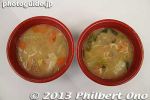
I usually eat two bowls. Only 250 yen per bowl.
|
|

It is really good! Different flavors are offered during different days of the tournament. Top is shoyu (soy sauce) flavor, and bottom is salt flavor. Miso flavor is also offered.
|
|

Lecture classroom (previously used as a dining room for chanko-nabe during tournaments). 相撲教習所
|
|

Next to the chanko dining room is a sumo ring for practice and deliberation exhibition matches.
|
|

The sign reads "Physical body, Technique, Heart." What you need to succeed in sumo.
|
|
|

Door to arena.
|
|
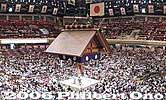
Panorama shot of sumo arena during a sumo tournament. There are two levels.
|
|

This is the lower level with zabuton box seats costing over 10,000 yen.
|
|

Box seats. Cramped space for four people.
|
|

Box seat for two.
|
|

Sumo ring and suspended roof (no pillars).
|
|

Shinto-style roof. If the house is full, the "Full House" banners are rolled down above the roof. (Now rolled up.)
|
|
|

Upper level and VIP booth.
|
|

VIP booth or "Royal Box" where the Emperor and Empress (or Crown Prince and Princess) or head of state watch sumo.
|
|

Upper level seats.
|
|

Upper level and giant sumo portraits of 32 past tournament winners. As of Jan. 2012, there are no portraits of Japanese sumo wrestlers. Only foreigners.
|
|

Giant portrait of Yokozuna AkebonoThese are B/W photographs painted over with oil.
|
|

Giant portrait of Yokozuna Takanohana
|
|

Giant portrait of Yokozuna Musashimaru
|
|

Giant portrait of Yokozuna Asashoryu
|
|

Giant portrait of Baruto
|
|
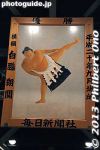
Giant portrait of Yokozuna Hakuho
|
|
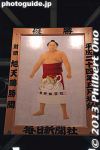
Giant portrait of Kyokutenho
|
|
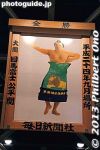
Giant portrait of Harumafuji
|
|
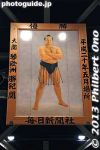
Giant portrait of Ozeki Kotooshu.
|
|

Sumo scoreboard. The names of all the wrestlers are displayed in the order of the sumo matches (from right to left). The winner is indicated with a red lamp. Names of sumo wrestlers absent from the tournament (due to injury, etc.) are listed on the far le
|
|
|
|
|
|
|